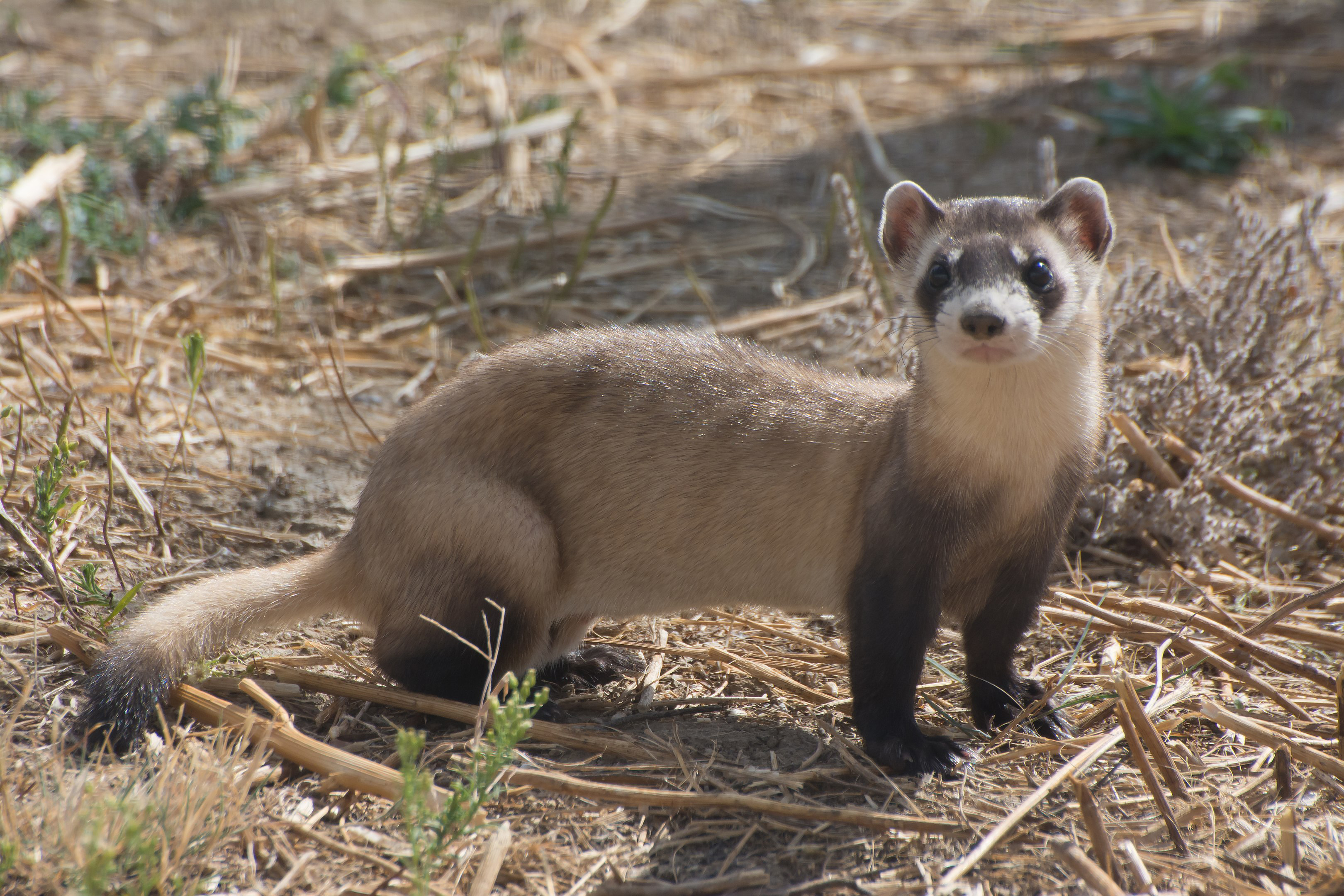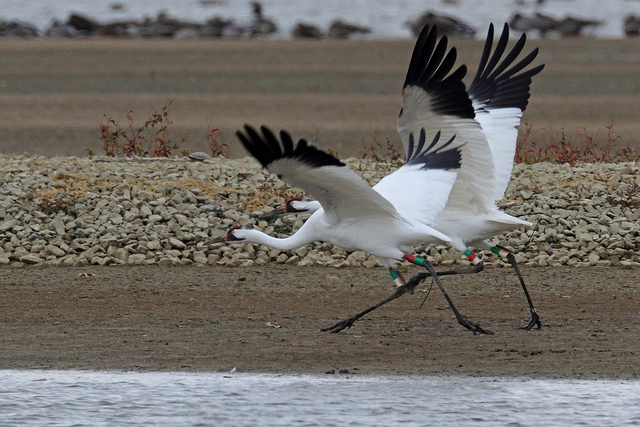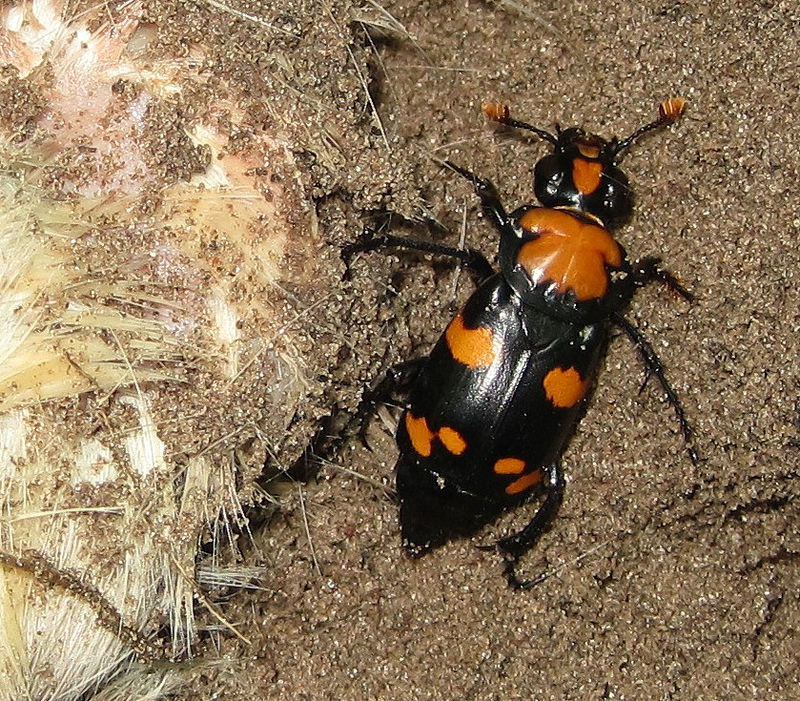
Bison skulls, in Detroit, MI, waiting to be ground up for fertilizer in 1892. Photo courtesy of Wikimedia Commons
Too often, when we think about the landscape of the prairie region, we think only about endless cultivated fields. In reality, the prairie is an astonishingly diverse biome, and the Midwest is home to numerous plant and animal species, some of which can be found nowhere else..
In recognition of this fact, in this issue of Rootstalk we are featuring a new addition to our regular “…of the Prairie” feature. In past we’ve highlighted prairie birds, mammals and trees; in this issue we’re recognizing four threatened animal species that call the prairie home.

Photo by Kimberly Fraser, courtesy of the U.S. Fish and Wildlife Service (USFWS), Mountain-Prairie division
The Black-footed ferret (Mustela nigripes)
Status: Critically endangered
Individuals in the wild: 370
This member of the weasel family preys primarily on prairie dogs, and this in large part accounts for its endangered status. As the open grasslands of the great plains have shrunk, so has the population of prairie dogs, and the population of the black-footed ferret along with them. In fact, this species’ numbers of plummeted so disastrously that for a while it was suspected that the species had gone extinct. A remnant population was found, however, and for the last thirty years a coalition of state and federal agencies, zoos, Native American tribes, conservation organizations and private landowners have combined efforts to give the black-footed ferret a second chance. Habitat loss and disease are still serious threats, however, and very few of these sleek and graceful animals remain living in the wild.
To see a collection of the World Wildlife Fund’s photos and videos on the black-footed ferret, clink this link.

Photo by Steve Gifford, courtesy of the U.S. Fish and Wildlife Service, taken at Patokah River National Wildlife Refuge, Indiana
The Whooping Crane (Grus americana)
Status: Critically endangered
Individuals in the wild: 85
The numbers of this acquatic bird—at five feet, the tallest in North America—cratered during the 19th century due to habitat loss and unregulated hunting for meat, eggs and feathers. Once this majestic bird nested on the northern prairies as far south as Iowa and Illinois, but its numbers dwindled until by 1941 the flock which wintered in Texas was down to 15 birds. Protection of the crane’s wintering grounds and conservation efforts helped the population to begin a rebound, but the number of birds living in the wild is still very slender. The Patuxent Wildlife Research Center, in Maryland, has a successful captive breedling program with 60 birds in it, and more recently, an ambitious project has established a new flock that summers at the Necedah National Wildlife Reserve in Wisconsin, with young birds raised and then trained to follow an ultralight aircraft 1,250 miles to Chassahowitzka National Wildlife Refuge in Florida as part of a U.S. Fish and Wildlife Service plan to reintroduce a migratory flock of whooping cranes into the East, where the last flock vanished 100 years ago.
To hear a whooping crane’s call, click on this link. Recording by Tom Lally for Cornell University’s Macauley Library

Photo by Lindsay Vivian, courtesy of the U.S. Fish and Wildlife Service, taken at Price Ranch near Burwell, Nebraska
The American Burying Beetle (Nicrophorus americanus)
Status: Threatened
Individuals in the wild: unknown
The American burying beetle got its name from its habit of burying small dead animals when it encounters them. The U.S. Fish and Wildlife service had listed this large beetle as an endangered species, but in October of last year “downlisted” it as threatened, but no longer in immediate danger of extinction.
Researchers aren’t entirely sure of the reasons for this distinctively marked insect’s decline, butspeculation is that—as is so often the case—the population has shrunk mostly because of habitat loss. The beetle once had a range that stretched across 150 counties in 35 states in the eastern and central United States, as well as in southern Canada in Ontario, Quebec and Nova Scotia. Now the beetle is found only in six states: Arkansas, Kansas, Nebraska, Oklahoma, Rhode Island, and South Dakota.
USFWS cautions that it is important to continue conservation efforts on the beetle’s behalf, as ongoing climate change and continuing urbanization and agricultural expansion will perpetuate the threat to its existence.
To watch a video on the Cincinnatti Zoo’s efforts to breed the endangered American burying beetle, clink this link.
 Taken at [Puchyan Prairie State Natural Area,](https://dnr.wi.gov/topic/Lands/naturalareas/index.asp?SNA=172) Wisconsin. July 3, 2006](https://rootstalk.blob.core.windows.net/rootstalk-2021-spring/grinnell_29930_OBJ.jpg)
Photo by Michael Reese for Wisconsin Butterflies. Taken at Puchyan Prairie State Natural Area, Wisconsin. July 3, 2006
The Poweshiek Skipperling (Oarisma poweshiek)
Status: Critically endangered
Individuals in the wild: under 500
Skipperlings constitute about 150 described species in a small subfamily (Heteropterinae) of skipper butterflies traditionally found in the states of the upper Midwest and the provinces of southern Canada. Because the Poweshiek skipperling lives exclusively on remnants of native prairie that have never been plowed, in recent years it has all but disappeared from its former range in Iowa, Minnesota, North Dakota, South Dakota, and Wisconsin. Recent butterfly censuses seem to indicate it can now only be found in fens in Michigan and in Manitoba. According to an article by the U.S. Fish and Wildlife Service, “Today there are far fewer Poweshiek skipperlings in the world than there are wild giant pandas.” According to the USFWS, additional causes for its sharp decline “remain a mystery,” but may include threats “such as an unknown disease or parasite, climate change or use of pesticides.”
There are still hopes that this little butterfly’s numbers can be bolstered through the efforts of projects like the Minnesota Zoo’s Prairie Butterfly Conservation Program.
Click on this link to hear a podcast on efforts to rescue the Poweshiek skipperling, recorded by Michigan State University’s public radio station, WKAR.

